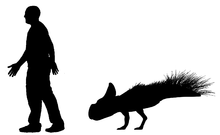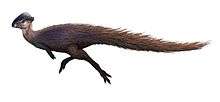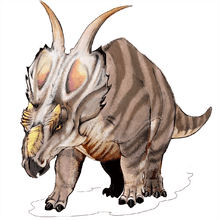Protoceratops
| Protoceratops Temporal range: Late Cretaceous, 75–71 Ma | |
|---|---|
 | |
| Mounted P. andrewsi skeleton, Carnegie Museum of Natural History | |
| Scientific classification | |
| Kingdom: | Animalia |
| Phylum: | Chordata |
| Class: | Reptilia |
| Clade: | Dinosauria |
| Order: | †Ornithischia |
| Family: | †Protoceratopsidae |
| Genus: | †Protoceratops Granger & Gregory, 1923 |
| Type species | |
| †Protoceratops andrewsi Granger & Gregory, 1923 | |
| Species | |
| |
Protoceratops (/ˌproʊtoʊˈsɛrətɒps/; from Greek proto-/πρωτο- "first", cerat-/κερατ- "horn" and -ops/-ωψ "face", meaning "First Horned Face")[1] is a genus of sheep-sized (1.8 m long) herbivorous ceratopsian dinosaur, from the Upper Cretaceous Period (Campanian stage) of what is now Mongolia. It was a member of the Protoceratopsidae, a group of early horned dinosaurs. Unlike later ceratopsians, however, it was a much smaller creature that lacked well-developed horns and retained some primitive traits not seen in later genera.
Protoceratops had a large neck frill which was likely used as a display site to impress other members of the species. Other hypotheses about its function include protection of the neck and anchoring of jaw muscles, but the fragility of the frill and the poor leverage offered by possible attachment sites here makes these ideas implausible. Described by Walter W. Granger and W.K. Gregory in 1923, Protoceratops was initially believed to be an ancestor of the North American ceratopsians. Researchers currently distinguish two species of Protoceratops (P. andrewsi and P. hellenikorhinus), based in part by their respective sizes.
In the 1920s, Roy Chapman Andrews discovered fossilized eggs in Mongolia that were interpreted as belonging to this dinosaur, but which turned out to be those of Oviraptor.
Description

Protoceratops was a quadrupedal dinosaur that was partially characterized by its distinctive neck frill at the back of its skull. The frill itself contained two large parietal fenestrae (holes in the frill), while its cheeks had large jugal bones.[2] The exact size and shape of the neck frill varied by individual; some specimens had short, compact frills, while others had frills nearly half the length of the skull. The frill consists mostly of the parietal bone and partially of the squamosal. Some researchers, including Peter Dodson[3] attribute the different sizes and shapes of these bones to sexual dimorphism, as well as the age of the specimen, at the time of death.
Protoceratops was approximately 1.8 meters (6 ft) in length and 0.6 meters (2 ft) high at the shoulder. A fully grown adult would have weighed less than 400 pounds (180 kg).[4] Smaller specimens are estimated at 23.7 kilograms (52 lb).[5] The large numbers of specimens found in high concentration suggest that Protoceratops lived in herds.[4]

Protoceratops was a relatively small dinosaur with a proportionately large skull. Protoceratops appears to have had muscular jaws capable of a powerful bite. These jaws were packed with dozens of teeth, well suited for chewing tough vegetation.[4] The skull consisted of a massive frontal beak, and four pairs of fenestrae (skull openings). The foremost hole, the naris, was considerably smaller than the nostrils seen in later genera. Protoceratops had large orbits (the holes for its eyes), which measured around 50 millimeters in diameter.[3] Behind the eye was a slightly smaller fenestra, known as the "infratemporal fenestra."
Discovery and species
.jpg)
Photographer James Blaine Shackelford discovered the first specimen of Protoceratops in the Gobi desert, (Gansu, Inner Mongolia), as part of a 1922 American expedition looking for human ancestors. No early human fossils were found, but the expedition, led by Roy Chapman Andrews, collected many specimens of the Protoceratops genus, along with fossil skeletons of theropods Velociraptor, Oviraptor, and ceratopsian Psittacosaurus.[3]
Walter Granger and W.K. Gregory formally described the type species, P. andrewsi in 1923, the specific name in honor of Andrews. The fossils hail from the Djadochta Formation and date from the Campanian stage of the Upper Cretaceous (dating to between 75 and 71 million years ago).[6] Researchers immediately noted the importance of the Protoceratops finds, and the genus was hailed as the "long-sought ancestor of Triceratops".[3] The fossils were in an excellent state of preservation, with even the sclerotic rings (delicate ocular bones) preserved in some specimens.[3]
In 1971, a fossil was found that captured a Velociraptor mongoliensis clutched around a Protoceratops andrewsi in Mongolia. It is believed that they died simultaneously, while fighting, when they were either surprised by a sand storm or buried when a sand dune collapsed on top of them.[7]

In 1975, Polish paleontologists Teresa Maryanska and Halszka Osmólska described a second species of Protoceratops, also from the Campanian stage of Mongolia, which they named P. kozlowskii.[8] However, the fossils consisted of incomplete juvenile remains, and are now considered synonymous with Bagaceratops rozhdestvenskyi.[9]
In 2001, a second valid species, P. hellenikorhinus, was named from the Bayan Mandahu Formation in Inner Mongolia, China and also dates from the Campanian stage of the Upper Cretaceous. It was notably larger than P. andrewsi, had a slightly different frill, and had more robust jugal horns. The arch of bone over its nostrils had two small nasal horns, and there were no teeth at the front of the snout.[10]
In 2011, a specimen of Protoceratops first uncovered in 1965 was found to be preserved with its own footprint. It is the first example of a dinosaur to be preserved with footprints.[11]
Paleobiology
Reproduction
In the 1920s, Roy Chapman Andrews discovered the first known fossilized dinosaur eggs, in the Gobi Desert of Mongolia. Each egg was about 8 inches long, and newborn hatchlings estimated to have been about a foot in length. Due to the proximity and abundance of Protoceratops, these eggs were believed at the time to belong to this genus.
The contemporary theropod Oviraptor was thought to consume Protoceratops eggs due to the discovery of an Oviraptor skeleton present at a nest. The skull was crushed, and it was speculated that the injury was received by a Protoceratops mother defending her nest from the predator.
However, in 1993 Norrell et al. discovered an embryo inside a supposed Protoceratops egg. This embryo, upon close examination, turned out be an Oviraptor;[12] the original find represented Oviraptor brooding behavior rather than a failed attempt at oophagy.
The oogenus Protoceratopsidovum (meaning "Protoceratops egg") was also originally misidentified as belonging to Protoceratops; it is now known to be the eggs of a derived theropod.[13]

In 2011, a nest of 15 young Protoceratops andrewsi was discovered in Mongolia.[14] Stated as being the first Protoceratops nest discovered to date, the discovery suggests that Protoceratops parents might have cared for their young at nests during at least the early stages of childhood.[14]
As Protoceratops is a relatively basal member of the ceratopsians, the finding also suggests that other ceratopsians provided care for their young as well.[14]
Daily activity patterns
The large eyes of Protoceratops has been suggested as evidence for a nocturnal lifestyle.[15] However, subsequent comparisons between the scleral rings of Protoceratops and modern birds and reptiles have indicated a more cathemeral lifestyle, being active throughout the day during short intervals. This suggests that the fight between Protoceratops and the primarily nocturnal Velociraptor indicated by the fighting specimens may have occurred at twilight or under low-light conditions.[16]
Classification
.jpg)
Protoceratops was the first named protoceratopsian and hence gives its name to the family Protoceratopsidae, a group of herbivorous dinosaurs more derived than psittacosaurids, but less derived than ceratopsids. The group is characterized by their similarities to the Ceratopsidae but with more cursorial limb proportions, generally smaller frills, and lack of large horns.
In 1998, Paul Sereno defined Protoceratopsidae as the branch-based clade including "all coronosaurs closer to Protoceratops than to Triceratops." Some studies placed Bagaceratops, Breviceratops, Graciliceratops, Lamaceratops, Magnirostris, Platyceratops, and Serendipaceratops within Protoceratopsidae, but in 2006, Makovicky and Norell published a new phylogeny which removed several genera from Protoceratopsidae; several other phylogenies also exist. Bainoceratops may be synonymous with Protoceratops.[17]
The cladogram below follows the topology from a 2015 analysis by Yiming He, Peter J. Makovicky, Kebai Wang, Shuqing Chen, Corwin Sullivan, Fenglu Han, Xing XuMichael J. Ryan, David C. Evans, Philip J. Currie, Caleb M. Brown and Don Brinkman.[18]
| Leptoceratopsidae |
| ||||||||||||||||||||||||||||||||||||||||||||||||||||||
| | |||||||||||||||||||||||||||||||||||||||||||||||||||||||
| |
| ||||||||||||||||||||||||||||||||||||||||||||||||||||||
| |
Origin of griffin myths

Folklorist and historian of science Adrienne Mayor of Stanford University has suggested that the exquisitely preserved fossil skeletons of Protoceratops and other beaked dinosaurs, found by ancient Scythian nomads who mined gold in the Tian Shan and Altai Mountains of Central Asia, may have been at the root of the image of the mythical creature known as the griffin. Griffins were described as lion-sized quadrupeds with large claws and a raptor-bird-like beak; they laid their eggs in nests on the ground.[19]
Greek writers began describing the griffin around 675 B.C., at the same time the Greeks first made contact with Scythian nomads. Griffins were described as guarding the gold deposits in the arid hills and red sandstone formations of the wilderness. The region of Mongolia and China where many Protoceratops fossils are found is rich in gold runoff from the neighboring mountains, lending some credence to the theory that these fossils were the basis of griffin myths.[3]
However, more recently this hypothesis has been seriously contested, as it is forced to ignore pre-Greek gryphon art and accounts.[20]
See also
References
- ↑ Liddell & Scott (1980). Greek-English Lexicon, Abridged Edition. Oxford University Press, Oxford, UK. ISBN 0-19-910207-4.
- ↑ Lambert, D. (1993). The Ultimate Dinosaur Book. Dorling Kindersley, New York. pp. 152–167. ISBN 1-56458-304-X.
- 1 2 3 4 5 6 Dodson, P. (1996). The Horned Dinosaurs. Princeton University Press, Princeton, New Jersey. pp. 200–234. ISBN 0-691-05900-4.
- 1 2 3 "Protoceratops." In: Dodson, Peter & Britt, Brooks & Carpenter, Kenneth & Forster, Catherine A. & Gillette, David D. & Norell, Mark A. & Olshevsky, George & Parrish, J. Michael & Weishampel, David B. The Age of Dinosaurs. Publications International, LTD. p. 118-119. ISBN 0-7853-0443-6.
- ↑ Seebacher, F. 2001. A new method to calculate allometric length-mass relationships of dinosaurs. Journal of Vertebrate Paleontology 21 (1). p. 53
- ↑ Godefroit, Pascal; Currie, Philip J.; Li, Hong; Shang, Chang Yong; Dong, Zhi-ming (2008). "A new species of Velociraptor (Dinosauria: Dromaeosauridae) from the Upper Cretaceous of northern China". Journal of Vertebrate Paleontology. 28 (2): 432–438. doi:10.1671/0272-4634(2008)28[432:ANSOVD]2.0.CO;2.
- ↑ Carpenter, Ken. (1998). "Evidence of predatory behavior by theropod dinosaurs.". Gaia. 15: 135–144. [not printed until 2000]
- ↑ Maryanska, T.; Osmólska, H. (1975). "Protoceratopsidae (Dinosauria) of Asia". Palaeontologica Polonica. 33: 133–181.
- ↑ You H. & Dodson, P. 2004. Basal Ceratopsia. In: Weishampel, D.B., Dodson, P., & Osmolska, H. (Eds.). The Dinosauria (2nd Edition). Berkeley: University of California Press. Pp. 478-493.
- ↑ Lambert, O, Godefroit, P, Li, H, Shang, C.-Y. & Dong,Z.-M. (2001). "A new species of Protoceratops (Dinosauria, Neoceratopsia) from the Late Cretaceous of Inner Mongolia (P. R. China)". Bulletin de l'Institut Royal des Sciences Naturelles de Belgique, Science de la Terre: 5–28.
- ↑ BBC Nature - Protoceratops Dinosaur found with its own tracks
- ↑ http://dallasdino.org/exhibits/dinoworld/Protoceratops.asp Archived February 19, 2006, at the Wayback Machine.
- ↑ Zelenitsky, D. K. And Therrien, F. (2008), "Phylogenetic Analysis Of Reproductive Traits Of Maniraptoran Theropods And Its Implications For Egg Parataxonomy." Palaeontology, 51: 807–816. Doi: 10.1111/J.1475-4983.2008.00770.X
- 1 2 3 Choi, Charles. "15 Infant Dinosaurs Discovered Crowded in Nest". LiveScience.com. November 17, 2011.
- ↑ Longrich, N. (2010). "The Function of Large Eyes in Protoceratops: A Nocturnal Ceratopsian?", In: Michael J. Ryan, Brenda J. Chinnery-Allgeier, and David A. Eberth (eds), New Perspectives on Horned Dinosaurs: The Royal Tyrrell Museum Ceratopsian Symposium, Indiana University Press, 656 pp. ISBN 0-253-35358-0.
- ↑ Schmitz, L.; Motani, R. (2011). "Nocturnality in Dinosaurs Inferred from Scleral Ring and Orbit Morphology". Science. 332 (6030): 705–8. doi:10.1126/science.1200043. PMID 21493820.
- ↑ Makovicky, P.J.; Norell, M.A. (2006). "Yamaceratops dorngobiensis, a new primitive ceratopsian (Dinosauria: Ornithischia) from the Cretaceous of Mongolia. 3530:1-42" (PDF). American Museum Novitates. 3530: 1–42. doi:10.1206/0003-0082(2006)3530[1:YDANPC]2.0.CO;2. Retrieved 2008-08-10.
- ↑ Yiming He, Peter J. Makovicky, Kebai Wang, Shuqing Chen, Corwin Sullivan, Fenglu Han, Xing XuMichael J. Ryan, David C. Evans, Philip J. Currie, Caleb M. Brown and Don Brinkman (2015). "A New Leptoceratopsid (Ornithischia, Ceratopsia) with a Unique Ischium from the Upper Cretaceous of Shandong Province, China".
- ↑ Mayor, A. (2000). The First Fossil Hunters: Paleontology in Greek and Roman Times. Princeton University Press, Princeton, New Jersey. ISBN 0-691-05863-6.
- ↑ Mark Witton, Why Protoceratops Almost Certainly Wasn't The Inspiration For Griffin Legend
External links
| Wikimedia Commons has media related to Protoceratops. |
- A video of Protoceratops vs Velociraptor
- Ceratopsia from Thescelosaurus web site
| Cretaceous Period | |
|---|---|
| Lower/Early Cretaceous | Upper/Late Cretaceous |
| Berriasian | Valanginian | Hauterivian Barremian| Aptian | Albian |
Cenomanian | Turonian | Coniacian Santonian |Campanian | Maastrichtian |

